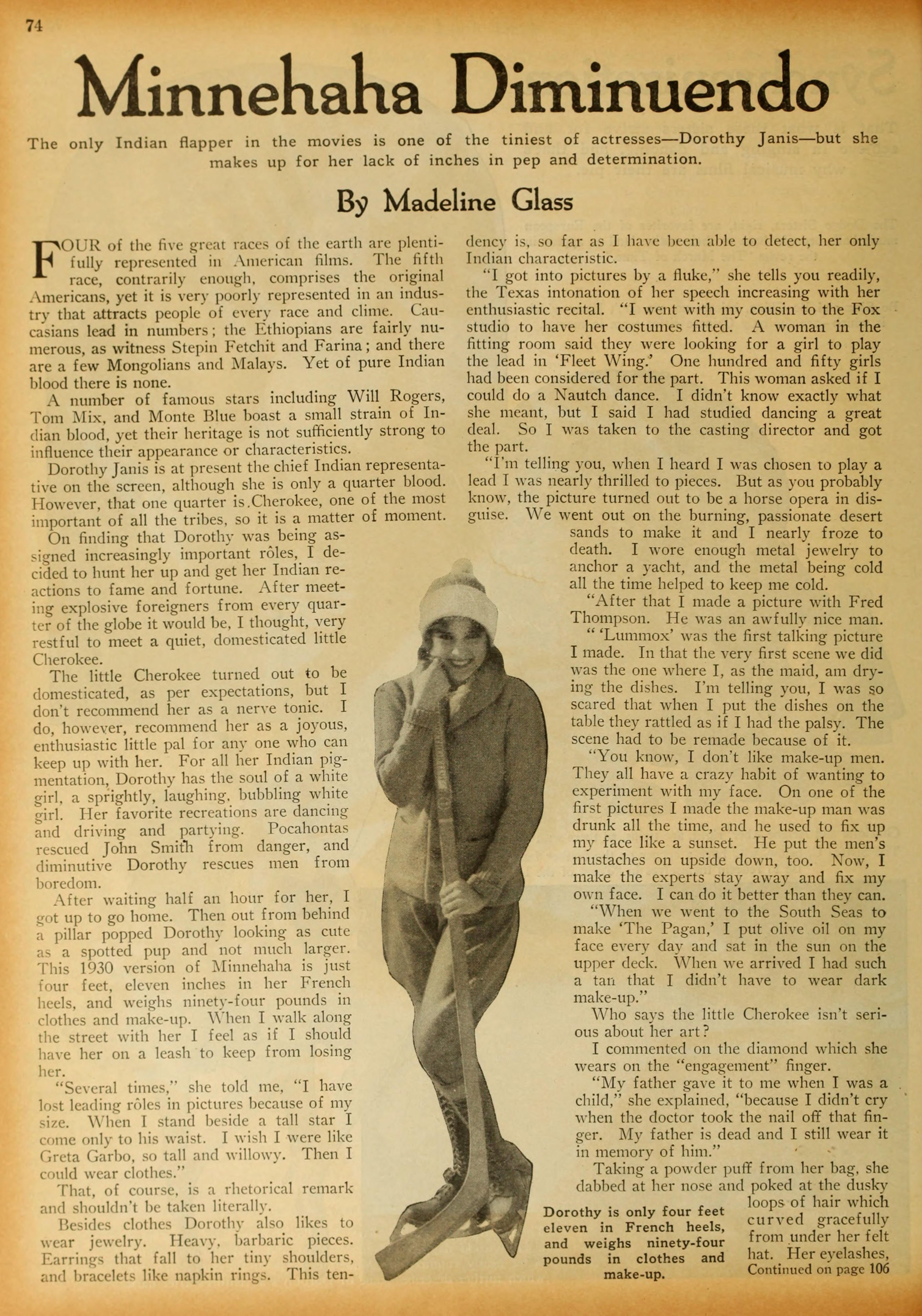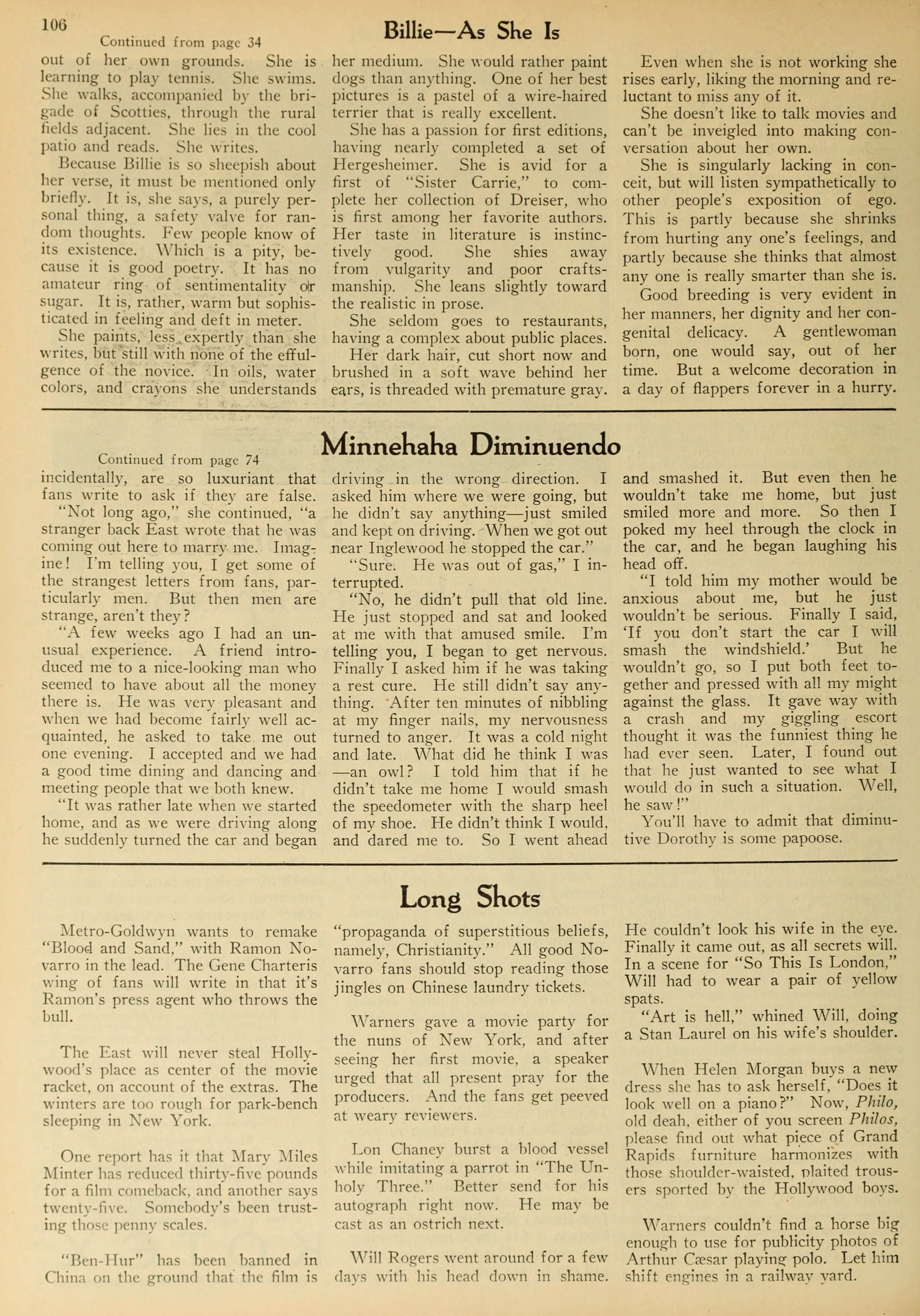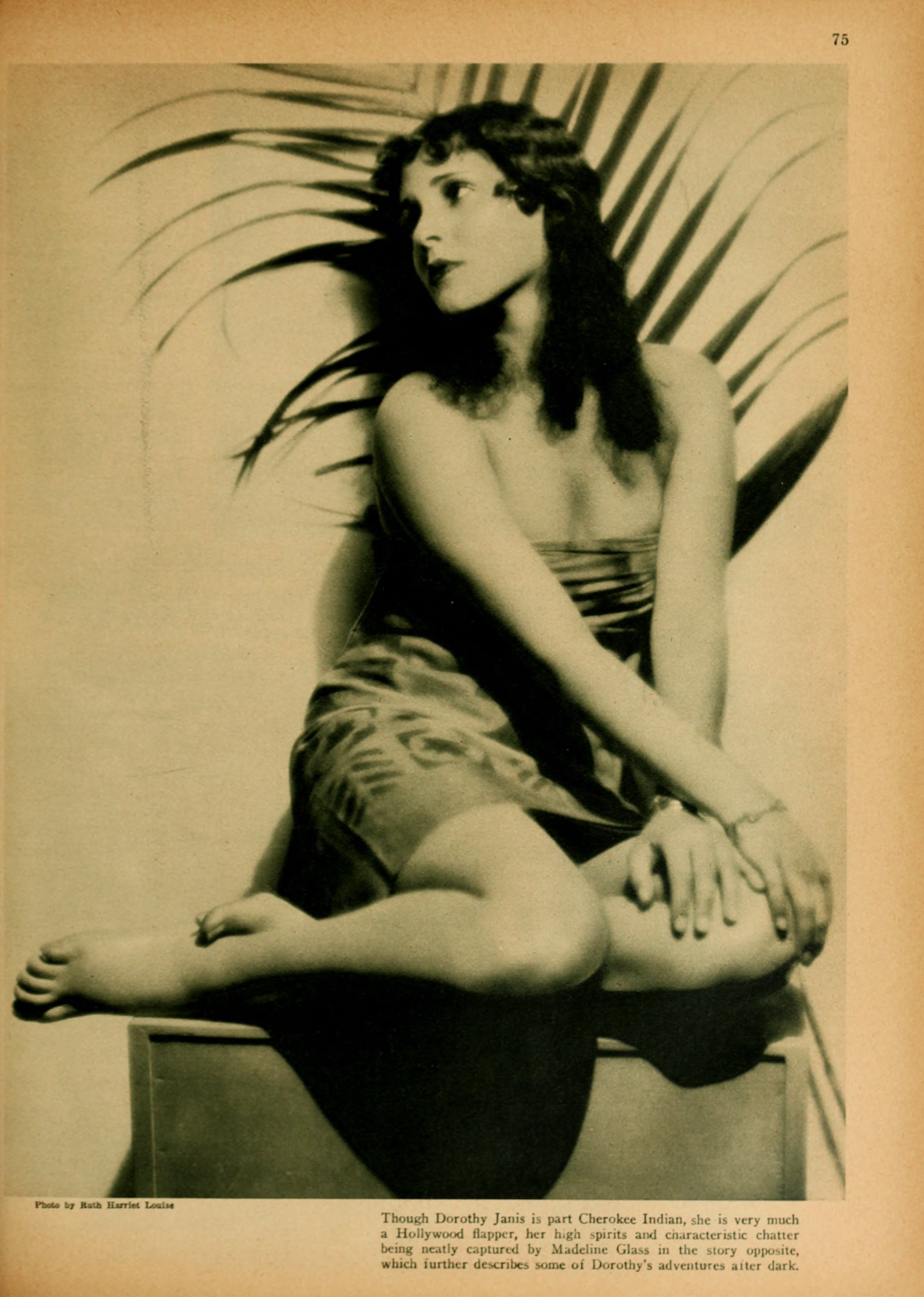Dorothy Janis — Minnehaha Diminuendo (1930) 🇺🇸

Four of the five great races of the earth are plentifully represented in American films. The fifth race, contrarily enough, comprises the original Americans, yet it is very poorly represented in an industry that attracts people of every race and clime. Caucasians lead in numbers; the Ethiopians are fairly numerous, as witness Stepin Fetchit and Farina; and there are a few Mongolians and Malays. Yet of pure Indian blood there is none.
by Madeline Glass
A number of famous stars including Will Rogers, Tom Mix, and Monte Blue boast a small strain of Indian blood, yet their heritage is not sufficiently strong to influence their appearance or characteristics.
Dorothy Janis is at present the chief Indian representative on the screen, although she is only a quarter blood. However, that one quarter is Cherokee, one of the most important of all the tribes, so it is a matter of moment.
On finding that Dorothy was being assigned increasingly important roles, I decided to hunt her up and get her Indian reactions to fame and fortune. After meeting explosive foreigners from every quarter of the globe it would be, I thought, very restful to meet a quiet, domesticated little Cherokee.
The little Cherokee turned out to be domesticated, as per expectations, but I don’t recommend her as a nerve tonic. I do, however, recommend her as a joyous, enthusiastic little pal for any one who can keep up with her. For all her Indian pigmentation, Dorothy has the soul of a white girl, a sprightly, laughing, bubbling white girl. Her favorite recreations are dancing and driving and partying. Pocahontas rescued John Smith from danger, and diminutive Dorothy rescues men from boredom.
After waiting half an hour for her, I got up to go home. Then out from behind a pillar popped Dorothy looking as cute as a spotted pup and not much larger. This 1930 version of Minnehaha is just four feet, eleven inches in her French heels, and weighs ninety-four pounds in clothes and make-up. When I walk along street with her I feel as if I should have her on a leash to keep from losing her.
“Several times,” she told me, “I have lost leading roles in pictures because of my size. When I stand beside a tall star I come only to his waist. I wish I were like Greta Garbo, so tall and willowy. Then I could wear clothes.”
That, of course, is a rhetorical remark and shouldn’t be taken literally.
Besides clothes Dorothy also likes to wear jewelry. Heavy, barbaric pieces. Earrings that fall to her tiny shoulders, and bracelets like napkin rings. This tendency is, so far as I have been able to detect, her only Indian characteristic.
“I got into pictures by a fluke,” she tells you readily, the Texas intonation of her speech increasing with her enthusiastic recital. “I went with my cousin to the Fox studio to have her costumes fitted. A woman in the fitting room said they were looking for a girl to play the lead in Fleetwing. One hundred and fifty girls had been considered for the part. This woman asked if I could do a Nautch dance. I didn’t know exactly what she meant, but I said I had studied dancing a great deal. So I was taken to the casting director and got the part.
“I’m telling you, when I heard I was chosen to play a lead I was nearly thrilled to pieces. But as you probably know, the picture turned out to be a horse opera in disguise. We went out on the burning, passionate desert sands to make it and I nearly froze to death. I wore enough metal jewelry to anchor a yacht, and the metal being cold all the time helped to keep me cold.
“After that I made a picture with Fred Thompson [Fred Thomson]. He was an awfully nice man.
“Lummox was the first talking picture I made. In that the very first scene we did was the one where I, as the maid, am drying the dishes. I’m telling you, I was so scared that when I put the dishes on the table they rattled as if I had the palsy. The scene had to be remade because of it.
“You know, I don’t like make-up men. They all have a crazy habit of wanting to experiment with my face. On one of the first pictures I made the make-up man was drunk all the time, and he used to fix up my face like a sunset. He put the men’s mustaches on upside down, too. Now, I make the experts stay away and fix my own face. I can do it better than they can.
“When we went to the South Seas to make The Pagan, I put olive oil on my face every day and sat in the sun on the upper deck. When we arrived I had such a tan that I didn’t have to wear dark make-up.”
Who says the little Cherokee isn’t serious about her art?
I commented on the diamond which she wears on the “engagement” finger.
“My father gave it to me when I was a child,” she explained, “because I didn’t cry when the doctor took the nail off that finger. My father is dead and I still wear it in memory of him.”
Taking a powder puff from her bag, she dabbed at her nose and poked at the dusky loops of hair which curved gracefully from under her felt hat. Her eyelashes, incidentally, are so luxuriant that fans write to ask if they are false.
“Not long ago,” she continued, “a stranger back East wrote that he was coming out here to marry me. Imagine! I’m telling you, I get some of the strangest letters from fans, particularly men. But then men are strange, aren’t they?
“A few weeks ago I had an unusual experience. A friend introduced me to a nice-looking man who seemed to have about all the money there is. He was very pleasant and when we had become fairly well acquainted, he asked to take me out one evening. I accepted and we had a good time dining and dancing and meeting people that we both knew.
“It was rather late when we started home, and as we were driving along he suddenly turned the car and began driving in the wrong direction. I asked him where we were going, but he didn’t say anything — just smiled and kept on driving. When we got out near Inglewood he stopped the car.”
“Sure. He was out of gas,” I interrupted.
“No, he didn’t pull that old line. He just stopped and sat and looked at me with that amused smile. I’m telling you, I began to get nervous. Finally I asked him if he was taking a rest cure. He still didn’t say anything. After ten minutes of nibbling at my finger nails, my nervousness turned to anger. It was a cold night and late. What did he think I was — an owl? I told him that if he didn’t take me home I would smash the speedometer with the sharp heel of my shoe. He didn’t think I would, and dared me to. So I went ahead and smashed it. But even then he wouldn’t take me home, but just smiled more and more. So then I poked my heel through the clock in the car, and he began laughing his head off.
“I told him my mother would be anxious about me, but he just wouldn’t be serious. Finally I said, ‘If you don’t start the car I will smash the windshield.’ But he wouldn’t go, so I put both feet together and pressed with all my might against the glass. It gave way with a crash and my giggling escort thought it was the funniest thing he had ever seen. Later, I found out that he just wanted to see what I would do in such a situation. Well, he saw!”
You’ll have to admit that diminutive Dorothy is some papoose.

Dorothy is only four feet eleven in French heels, and weighs ninety-four pounds in clothes and make-up.


Though Dorothy Janis is part Cherokee Indian, the is very much a Hollywood flapper, her high spirits and characteristic chatter being neatly captured by Madeline Glass in the story opposite, which further describes Dorothy’s adventures alter dark.
Photo by: Ruth Harriet Louise (1903–1940)
Collection: Picture Play Magazine, October 1930
